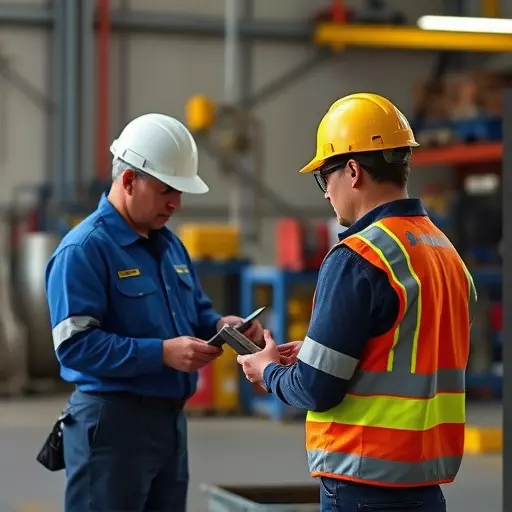In today's digital age, workplace safety training is evolving through immersive technologies like online platforms and virtual reality (VR) simulations. These innovations enhance interactivity, accessibility, and knowledge retention, ensuring OSHA compliance with up-to-date standards. By accommodating diverse learning styles, tracking employee progress, and providing targeted sessions, digital platforms foster a culture of proactive safety awareness. Future trends include VR/AR-driven immersive experiences for dynamic hazard identification training and AI-powered data analytics to predict and mitigate risks, revolutionizing worker preparation and improving workplace safety outcomes.
“In today’s digital era, the landscape of workplace safety is undergoing a significant transformation. This article explores cutting-edge technology trends shaping the future of safety programs. From evolving training methods to data-driven risk mitigation, organizations are leveraging innovative solutions for enhanced workplace safety.
We delve into key areas such as advanced hazard identification techniques, digital OSHA compliance training, and immersive learning experiences. Additionally, we examine how data analytics and AI are revolutionizing predictive risk management.”
- The Evolving Landscape of Workplace Safety Training
- Leveraging Technology for Effective Hazard Identification
- OSHA Compliance Training in the Digital Age
- Immersive Training Methods: Enhancing Learning Experiences
- Data Analytics and AI: Predicting and Mitigating Risks
The Evolving Landscape of Workplace Safety Training
The landscape of workplace safety training is constantly evolving to meet the changing demands and challenges of modern work environments. Traditional methods are being revolutionized by digital tools, making training more interactive and accessible than ever before. Online platforms and virtual reality (VR) simulations offer immersive experiences that allow employees to practice hazard identification and response in safe, simulated settings. This shift towards digital training enhances knowledge retention and ensures OSHA compliance with up-to-date standards.
With the increasing complexity of industrial processes and new workplace hazards emerging, effective safety training is more crucial than ever. By integrating cutting-edge technology into their programs, organizations can ensure that employees are equipped to identify potential risks, respond to emergencies, and adhere to safety protocols consistently. This evolution in workplace safety training not only improves employee preparedness but also fosters a culture of safety consciousness across all levels of an organization.
Leveraging Technology for Effective Hazard Identification
In today’s digital era, leveraging technology for effective hazard identification in the workplace has become an indispensable tool for ensuring safety and OSHA compliance. Advanced software and applications are now capable of analyzing vast datasets to identify potential risks and hazards that might be overlooked during traditional manual assessments. These technologies use machine learning algorithms to process historical data, incident reports, and real-time sensor readings to predict and prevent accidents.
Workplace safety training has significantly evolved with these innovations. Interactive digital platforms deliver hazard identification training that goes beyond basic lectures. They incorporate immersive simulations, interactive scenarios, and gamified elements to engage employees in practical risk assessment exercises. This not only enhances knowledge retention but also fosters a culture of proactive safety awareness, empowering employees to identify and mitigate potential hazards in their work environments.
OSHA Compliance Training in the Digital Age
In the digital age, OSHA compliance training is undergoing a significant transformation to meet the evolving needs of modern workplaces. Traditional in-person seminars and workshops are giving way to interactive online platforms that offer flexibility and accessibility for employees worldwide. This shift not only accommodates diverse learning styles but also enables more frequent and targeted training sessions tailored to specific job roles and industries. With advanced multimedia elements, simulations, and gamified modules, digital OSHA training enhances knowledge retention and engagement.
Digital platforms also facilitate continuous tracking of employee progress and performance, ensuring that everyone stays up-to-date with the latest safety protocols. This data-driven approach allows for rapid identification of knowledge gaps and areas requiring additional hazard identification training. By leveraging technology, organizations can foster a culture of safety excellence, empowering employees to recognize and mitigate risks effectively in their respective workstations.
Immersive Training Methods: Enhancing Learning Experiences
The future of workplace safety training is here, and it involves immersive experiences that go beyond traditional methods. With advanced technologies like virtual reality (VR) and augmented reality (AR), organizations are now able to create dynamic and realistic scenarios for employees to practice hazard identification and mitigation. This hands-on approach not only enhances learning retention but also prepares workers for real-world challenges, ensuring they can react effectively in potentially dangerous situations.
Immersive training offers a safe environment to simulate various workplace hazards, from chemical spills to equipment malfunctions. By stepping into these virtual scenarios, employees develop a deeper understanding of OSHA compliance regulations and the critical thinking skills needed to quickly make life-saving decisions. This innovative method of training is transforming how workers are prepared, making learning experiences more engaging, memorable, and ultimately effective for improving workplace safety outcomes.
Data Analytics and AI: Predicting and Mitigating Risks
In the realm of modern workplace safety, data analytics and artificial intelligence (AI) are emerging as powerful tools to predict and mitigate risks. By leveraging machine learning algorithms, organizations can analyze vast datasets from various sources, including employee reports, sensor data, and historical incident records, to identify patterns and potential hazards that may be overlooked during traditional hazard identification training. This predictive capability allows for proactive measures to be taken, enhancing OSHA compliance training and overall workplace safety.
AI-driven systems can also personalize workplace safety training by adapting to individual worker needs and performance. They can identify knowledge gaps through continuous assessment, ensuring that essential OSHA compliance training remains effective and up-to-date. This customized learning approach not only improves information retention but also fosters a culture of safety consciousness, as employees are equipped with the latest risk mitigation strategies.


